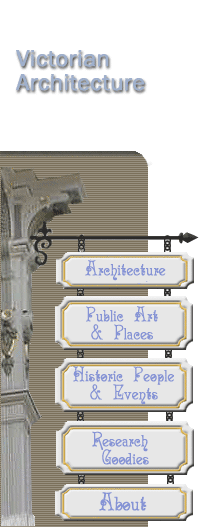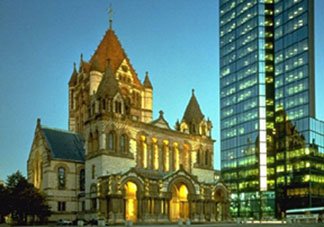
| 
Trinity Church
H.H. Richardson,
Built 1872 - 1877
 James O'Gorman
described Trinity as "a cultural event of the first importance in American
history." The building both represents a departure of the Boston's mind
from its Puritan past, and emergence of American creativity as a force in
architecture. However, Trinity didn't happen for architecture's sake, it
happened in no small part because of its pastor, Phillips
Brooks. James O'Gorman
described Trinity as "a cultural event of the first importance in American
history." The building both represents a departure of the Boston's mind
from its Puritan past, and emergence of American creativity as a force in
architecture. However, Trinity didn't happen for architecture's sake, it
happened in no small part because of its pastor, Phillips
Brooks.
Richardsonian Romanesque
Like all Romanesque architecture, Trinity is articulated with round-headed
arches. The Richardsonian style draws on the strength of rusticated
rock faces, with structural features like arches and lintels
made of a different type of stone. Plain areas left almost unfinished are
also part of the style. Deep window revels and wrought
iron ornaments amplify the building's feeling of massiveness. Rounded
protruding bays topped with cones, and square towers are topped with pyramidal
tops are hallmarks of this style.
Richardson used bold ornamentation in ways that define sections of the building.
Here on Trinity, the lower part of the building is dark, the top is red.
Chevrons highlight the front protrusion of the church. A continuous band
of checkerboard circles the chapel, like a belt, bringing the lower and
upper sections together. Though incorporating styles from many origins,
Richardson disciplined his designs. Form served function, and was often
based on the careful use of ratios and symmetrical balance.
Trinity's Unusual Construction
40 years before Trinity was built the 580 acres comprising Boston's Back
Bay neighborhood were tidal marsh and unable to support buildings. Turning
this marsh into a fashionable neighborhood and nearly doubling the city's
area makes filling the
Back Bay one of America's most ambitious public works projects.
Trinity Church's main building materials are Monson granite and Longmeadow
sandstone. Its tower alone weighs 90 million pounds. To support this immense
weight, 4000 cedar piles were pounded beneath the water table in a ninety
foot square. Unlike its neighbor The
Hancock Tower which had the advantage of manufactured materials like
concrete and iron piles, all the piles supporting Trinity Church are made
of wood.
These piles support four granite pyramids (35 feet square, and 17 feet high)
which form a "pass through" area where water rises and falls. If the wooden
piles are exposed to air they would begin to rot. A pumping system measures
the underground water level, and keeps it somewhere in the 17 foot range
of the pyramids. The same wooden piles have supported Trinity Church since
its construction. |
|
| INTRODUCING |
|
From the writers of iBoston.org |
|
|
|



